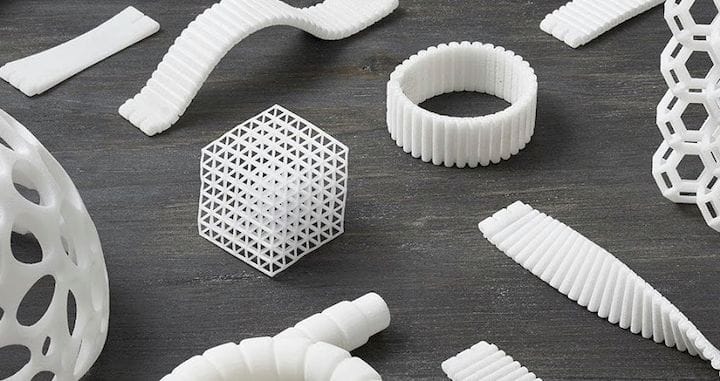![New 3D printing materials from Shapeways [Source: Shapeways']](https://fabbaloo.com/wp-content/uploads/2020/05/shapeways-new-materials_result_img_5eb099f731df2.jpg)
Today Shapeways announced the availability of two new 3D print materials, but I’m now wondering if there is something more going on behind the scenes.
First the announcement. Actually, there are more than one. Last week the well-known 3D print service announced the availability of a bio-degradable PA11 (nylon) material suitable for 3D printing prosthetics, in conjunction with their long-time partner, EOS.
Then today the company announced the availability of two additional new materials: PA12 Glass Beads, and TPU. The PA12 Glass Beads is essentially nylon material reinforced by combining it with very small glass particles. Apparently it is 40% glass by weight. Shapeways says:
“Creating stronger 3D printed designs, the new materials are an improvement of what was previously offered on the market. PA12 is 40% glass and eliminates previous concerns of warping and distorting that could happen to larger and flat items during the cooling/printing process.”
This produces a material that is very strong, yet still able to take some impact. It will be quite useful for mechanical prototypes, for example.
The other material, TPU, is one of the flexible materials available elsewhere in the 3D space. Shapeways says it is a great improvement over elastomers, which are also flexible, but stretchable. TPU is not stretchable, but is flexible. Thus it is appropriate for certain applications.
These are all terrific additions to the list of possible materials available at Shapeways to be sure, but is there something more afoot?
The first thing I noticed is that all of these materials could be classified as “engineering materials”. They would be most frequently used by those producing engineering models, low volume production units or prototypes.
These we would classify as “professional” applications, a category of 3D printing use that seems to have emerged over the past few years.
This new market is quite profitable for participants, and that has attracted multiple 3D printer manufacturers who have designed (or re-designed) their products to meet that market’s needs. Typically the major feature is the ability to 3D print in engineering materials, just like Shapeways seems to be doing here.
Shapeways has a history that parallels that of many desktop 3D printer manufacturers: they began as a means for consumers and artists to obtain 3D prints without having to acquire and operate their own 3D printers, an attractive prospect for many.
Since their launch they have indeed attracted many in that market, often by using strategic features. For example, they created a means for artists to develop their own online Shapeways stores to diversify the marketing efforts and attract more business, which we understand was quite successful.
However, others in the desktop 3D printing market generally suffered as consumer interest lagged and the expected boom never arrived. Many operations shifted their focus towards the professional market, such as Ultimaker, MakerBot, and many others.
Even 3D print services were not immune to this phenomenon: 3D Hubs, a 3D print community network, has shifted their approach to instead focus on industrial 3D printing.
Now we see Shapeways introducing more engineering materials, and even specializing in one case on medical applications. This could mean they’ve been feeling the same pressure as most other 3D printing organizations and are beginning their shift towards a more professional client base.
But who knows, they have not announced anything of the like, so we will have to observe their moves over the next year to see what happens.
Via Shapeways











MakerOS has a brilliant hidden feature in their online service: a sophisticated 3D print pricing calculator that allows operators to determine exactly how to price prints.